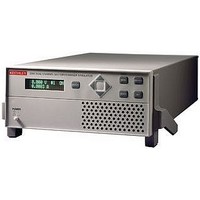2306 KEITHLEY, 2306 Datasheet - Page 2

2306
Manufacturer Part Number
2306
Description
58T8423
Manufacturer
KEITHLEY
Specifications of 2306
No. Of Outputs
2
Output Voltage
15V
Output Voltage 2
15V
Output Current
5A
Output Current 2
5A
Load Regulation
0.01%
Length
411mm
Width
213mm
Height
89mm
Weight
3.2kg
Power Supply Output Type
Variable
Input Voltage
100VAC To 120VAC / 220VAC To 240VAC
Power Rating
50W
Available stocks
Company
Part Number
Manufacturer
Quantity
Price
Company:
Part Number:
2306019201W
Manufacturer:
AGILENT
Quantity:
336
Company:
Part Number:
23061-1V
Manufacturer:
HRS
Quantity:
2 000
Part Number:
230619121242
Manufacturer:
VISHAY/威世
Quantity:
20 000
Part Number:
230619121302
Manufacturer:
VISHAY/威世
Quantity:
20 000
Part Number:
230619124752
Manufacturer:
VISHAY/威世
Quantity:
20 000
Company:
Part Number:
230622
Manufacturer:
BSI
Quantity:
30 000
Company:
Part Number:
2306566
Manufacturer:
Phoenix Contact
Quantity:
275
Conventional Power Supplies
and Wireless Device Testing
During production testing, supplying
power to a device that undergoes large,
instantaneous load current changes can be
extremely difficult. Changes like this force
a conventional power supply’s output volt-
age to fall instantaneously. When the power
supply’s control circuitry senses the error
condition (the difference in voltage between
the programmed level and the actual
level), it attempts to correct or restore the
voltage to the programmed level. During
this time, the voltage will fall or droop
substantially, with the amount of the droop
depending on the size of the load current
change. The recovery time depends on the
transient response of the power supply’s
control loop. Conventional power supplies
have transient voltage drops of >1V when
confronted with load current changes of
up to 1000%, and take up to a millisecond
to recover to the programmed voltage. For
portable devices such as cellular phones
that operate at full power for only short
intervals, the full power event is over before
the conventional power supply can recover.
For example, a cellular phone designed to
the GSM cellular phone standard transmits
and receives information in 576µs pulses. If
the power supply used to test these types of
phones cannot recover quickly enough, the
performance of the phone during testing
will be compromised by the power supply.
If the power supply voltage drops below the
threshold of the phone’s low battery detec-
tion circuitry for long enough, then the
phone will turn off during testing, giving a
false indication of a failed device.
Ordering Information
2302
2306
2306-PJ Dual-Channel Battery/
Accessories Supplied
User and service manuals,
CS-846 output connectors
mating terminal
1.888.KEITHLEY
2302
2306, 2306-PJ
w w w.keithley.com
Battery Simulator
Dual-Channel Battery/
Charger Simulator
Charger Simulator
with 500mA Range
(U.S. only)
Figure 2. Comparison of the voltage outputs of a lithium-ion battery (with an internal resistance of
260mW) and the Model 2306’s battery channel (programmed with an output resistance of 260mW)
when powering a cellular telephone as it makes the transition from standby mode to transmit mode.
In response to large load changes, the Model
2302 and the battery channel of the Model 2306
have transient voltage droops of less than 100mV
and transient recovery times of less than 60µs,
even when the test leads between the power
supply and the DUT are long. This fast transient
response, combined with the supplies’ vari-
able output resistance, allows engineers to test
their portable products under the most realistic
operating conditions and eliminate false failures
due to conventional power supplies with slow
response times. (See the sidebar titled “Con-
ventional Power Supplies and Wireless Device
Testing.”) These supplies also eliminate the large
stabilizing capacitors needed at the DUT to com-
pensate for the large droop that occurs when
testing with conventional power supplies. By
varying the output resistance, which can be done
while the output is turned on, test engineers can
simulate the operation of different battery types,
as well as batteries nearing the end of their
useful lives.
The Models 2302 and 2306 ensure maximum
production throughput when testing portable
Figure 3. Built-in pulse current measurement functions allow test engineers to measure peak,
average, and baseline load currents.
Battery Simulator
Battery/Charger Simulators
Average current level
High current level
Trigger level
Low current level
A
G R E A T E R
(out to 60s with long integration)
High
Time
M E A S U R E
Average Time
devices by minimizing false failures, minimizing
the number of test setups by performing mul-
tiple tests with the same power supply, and mini-
mizing test fixture complexity by eliminating the
need for voltage-stabilizing capacitors.
Measure Load Currents for
Power Consumption Verification
or Analysis
As manufacturers of portable devices strive to
extend their products’ battery life, measuring
load currents accurately has become increasingly
essential in both design and production test in
order to ensure the product meets its demanding
specifications. Comprehensive testing of these
devices requires measuring peak currents, aver-
age currents, and baseline currents in various
operation modes. When testing these devices,
these measurements are complicated by the pul-
sating nature of load currents, such as the trans-
mit and receive load currents of digital cellular
phones. The Models 2302 and 2306 can measure
the peak and average currents of pulses as short
as 60µs and as long as 833ms. (See Figure 3.)
O F
Low Time
C O N F I D E N C E











